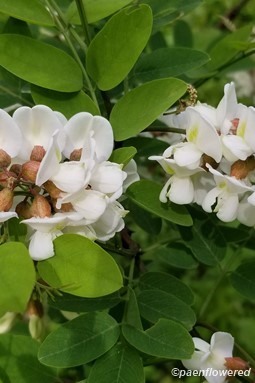Robinia pseudoacacia
An inhabitant of open areas, this tree has pea-like fragrant white flowers blooming in early summer
Robinia pseudoacacia black locust
This medium-sized tree is common throughout most of the state and blooms in open woodlands and along roadsides. It is native to the Appalachian and Ozark regions of United States but has naturalized or been planted in temperate regions around the world. It is, however, native in Pennsylvania. It is a legume of the pea family and fixes nitrogen to enrich the soil with nitrates. This allows it to grow in normally poor-quality soil. The tree does best in full sun.
The black locust tree has pinnately compound leaves with 6-20 egg-shaped leaflets. The entire leaf can be 6-12 inches long. Insects, often leaf miner beetles and their larva, frequently chew the leaves and leave holes. There are also strong, paired thorns that are ½ to 1 inch long that emerge beside the circular leaf scars. Mature trees may lack these thorns. The twigs are moderately stout, hairless, and deeply ridged. The tree can grow 70-80 feet high, but larger specimens are known. Its diameter is usually 2-3 feet when mature.
The tree blooms in May or June producing 4-5 inch long clusters of fragrant white flowers that closely resemble pea flowers in many ways. These flowers only last seven to ten days. The flowers are a major nectar source for bees. The resulting fruits are flat pods that are 2-6 inches long.
The wood is good quality but often ruined by locust borer insects. In spite of the damage insects cause, the species seems to survive in shrubby form by putting out extra sets of leaves. The bark, leaves, and wood are toxic. In many areas the black locust is considered invasive, especially when it grows in the grasslands and savannah of the American Midwest. Sometimes it is called false acacia, a literal translation of its species name. The locust tree of the entire Mediterranean Basin (Ceratonia siliqua or carob tree) is supposed to be the true locust mentioned in the New Testament.
Habitat & Range
Grows in open woods, floodplains, thickets, and fencerows.
Present throughout the state.
| EMP: | FACU |
|---|---|
| NCNE: | FACU |
Phenology
Flowers May through June.
Plant Codes
S-rank: S5 (Secure)
G-rank: G5 (Secure)











Comments
Have you spotted this plant in your area? We'd love to hear about your experience! Share your comments or questions about the plant below. Comments are moderated before posting.